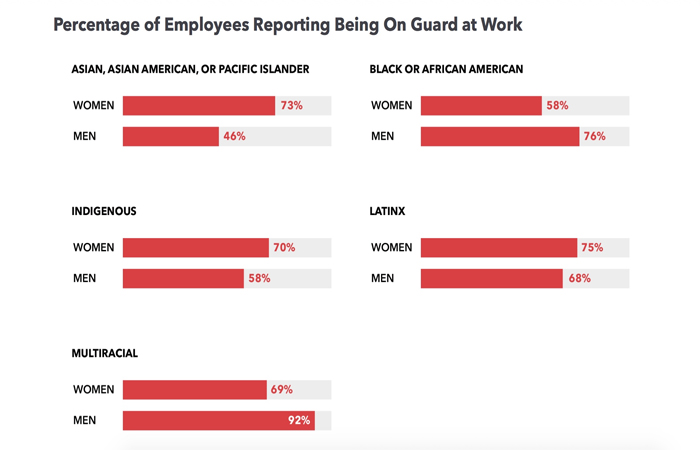Around 68% of employees of colour have reported being “on guard” at work to protect against racial bias and unfair treatment, according to Catalyst’s latest research. In fact, 70% of this group confirmed that they are on guard specifically because of their race or ethnicity.
The research entitled Allyship and Curiosity Drive Inclusion for People of Colour at Work, shows that people of colour experience bias, discrimination and unfair treatment in all parts of their lives – including at work – with far-reaching impact. In addition, the study found that many employees of colour in the US and Canada experience an emotional tax at work. That’s the combination of being on guard to protect against bias because of race, ethnicity and gender and experiencing the associated effects on health, well-being and ability to thrive at work.
The non-profit’s findings reveal that even amongst colleagues/team members with whom they work closely, two-thirds of employees of colour have needed to guard themselves against bias within the past six months. They brace themselves for insults, avoid certain places or social situations, change the way they look, and protect against being stereotyped by their team members – simply because of who they are.
The chart below demonstrates the exceptionally high numbers of both men and women of colour reporting being “on guard” at work. The statistics are high for all groups, but extremely concerning for Multiracial men (92%), Black men (76%), as well as Latin women (75%) and Asian American women (73%).

CREATING FAIR & INCLUSIVE WORKPLACES
Creating an environment where people of colour don’t need to be on guard is linked to both improved employee outcomes and benefits to the organisation, confirmed Catalyst’s research. When people of colour are less on guard to racial bias at work, they report that their organisations are more fair and invested in diversity and inclusion, and have supportive coworkers. As a result, they feel more included and have greater intentions to stay at their organisation.
Catalyst believes that corporate leaders, team managers and colleagues need to do a better job of creating the kind of work environments where everyone is valued for their diverse skills, expertise and background. Inclusive, curious leaders and allyship are key to drive inclusion for people of colour in the workplace, confirmed its research. The report’s co-author Sheila Brassel, PhD, says curiosity in leaders fuels allyship by allowing them “to access the specific information about diversity, difference, and their colleagues” that they need to become more effective change agents.
Brassel defines allyship as a means of “actively supporting people from marginalised groups … using as much institutional, social, and/or cultural privilege or power as you have to advocate” for them. She defines curiosity as “proactively seeking out different points of view, listening to others, learning, and reflecting on what you’ve heard.” A curious leader should be “open to new perspectives, welcome respectful exchanges of ideas, and channel their learning into action”, she adds.

WHY AUTHENTIC ALLYSHIP MATTERS
Catalyst’s research also confirmed that inclusive leaders successfully increase experiences of acceptance and inclusion at work for people of colour, which in turn boosts retention of these employees. However, the report cautions senior leaders to avoid “performative allyship”, which often maintains the status quo by appearing to support change without making real, equitable change for employees. The report warns against “appearing to speak out against various injustices without actually changing one’s behaviour or actively advocating against structures that uphold that injustice”.
Performative allyship hurts the people it purports to promote because it gives the impression of “doing something” when nothing of substance has occurred, noted the report. Thus, it maintains the status quo by appearing to support change without making change – which is inequitable and demoralising. Saying you’re against a certain type of injustice without doing the hard work of changing your behaviour or the structures that uphold it – is detrimental to both the people and causes you support.
PERFORMATIVE ALLYSHIP EXAMPLES
Examples of performative allyship include:
- Posting an article about racial injustice on social media without any further action to press for change, such as starting a conversation about the topic at work, making different spending decisions, or advocating for change in your community.
- Calling for more diversity in the media, but rarely watching, reading, or listening to work by people of colour.
- Stating that you’re shocked and angry about the latest example of social injustice without following up to learn more about how our society has nurtured this injustice for generations.
- Commemorating Equal Pay Day but not actually auditing salaries by gender and race to assess the extent to which there are pay gaps within the organisation.
- Saying that Black Lives Matter but continuing to work with vendors and suppliers with a history of marginalising Black employees and communities.
Catalyst urges leaders to go beyond performative allyship and become true allies. In other words, to become allies who use their power, influence, expertise, resources, skills and relationships to advocate for individual and structural change. Doing so requires pushing back against long-standing social and cultural norms, habits, expectations and traditions.
Commenting on the latest report findings, Catalyst President & CEO Lorraine Hariton, stated: “As we continue to experience the impact of the Covid-19 pandemic and of social justice movements across the globe, leaders of organisations have an opportunity to become true allies to employees of colour. We hope this study serves as a guide for senior leaders and managers to cultivate and lead inclusive workplaces.”
Click here for more information.







































